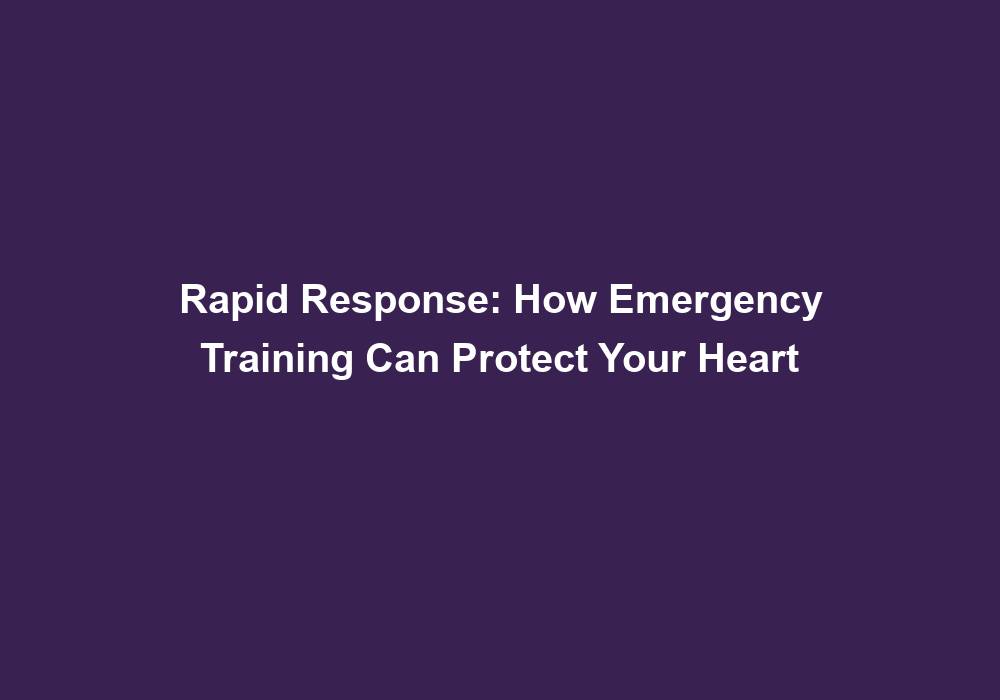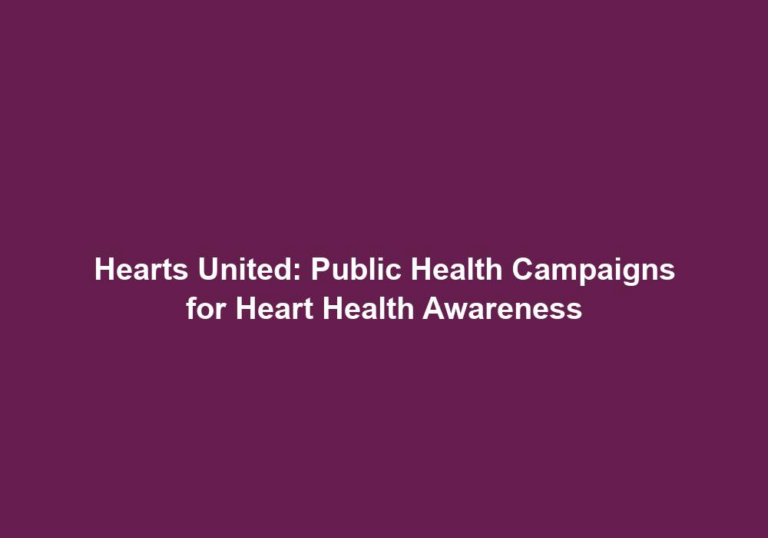Rapid Response: How Emergency Training Can Protect Your Heart
In today’s fast-paced world, emergencies can happen unexpectedly and without warning. Whether it’s a sudden cardiac arrest or a severe injury, having the knowledge and skills to respond quickly can make all the difference in saving a life. That’s why emergency training is not just important, but essential, especially when it comes to protecting your heart. In this article, we will delve into the significance of emergency training and how it can safeguard your heart health.
What is Emergency Training?
Emergency training refers to the education and practice of life-saving techniques that can be used during critical situations. It involves learning first aid, cardiopulmonary resuscitation (CPR), and other essential skills necessary to provide immediate assistance until professional help arrives. By undergoing emergency training, individuals gain the confidence and ability to take action in high-stress situations.
The Link Between Emergency Training and Heart Health
-
Early Intervention: Cardiac emergencies, such as heart attacks, require swift intervention to prevent further damage. Emergency training equips individuals with the knowledge to recognize the signs and symptoms of a heart attack, allowing them to react promptly. By initiating CPR or using automated external defibrillators (AEDs) until medical professionals arrive, bystanders can significantly increase the chances of survival for heart attack victims.
- By recognizing the signs of a heart attack, such as chest pain, shortness of breath, and discomfort in the upper body, individuals trained in emergency techniques can take immediate action.
- CPR, a crucial skill taught in emergency training, involves performing chest compressions and rescue breaths to maintain blood flow and oxygenation to the vital organs. By initiating CPR promptly, the chances of successful resuscitation are greatly enhanced.
- Automated external defibrillators (AEDs) are portable devices that deliver an electric shock to the heart in cases of sudden cardiac arrest. Emergency training teaches individuals how to operate these devices effectively, ensuring proper usage when every second counts.
-
Reducing Response Time: Time is of the essence during a cardiac emergency. The immediate response provided by individuals trained in emergency techniques can greatly reduce the time it takes for life-saving measures to be administered. Every minute without intervention during a heart attack decreases the likelihood of survival. By having trained individuals nearby, rapid response time can be achieved, potentially saving precious lives.
- Trained individuals are able to assess the situation quickly and take appropriate action, minimizing the delay in providing critical care.
- By knowing the proper steps to take and having the necessary skills, such as CPR and using AEDs, individuals can act swiftly and effectively, potentially improving the outcomes for those experiencing a cardiac emergency.
- Having trained responders in various locations, such as workplaces, schools, and public spaces, can significantly reduce the time it takes for help to arrive and increase the chances of survival.
-
Empowering Bystanders: During an emergency, bystanders are often the first to witness an incident. By receiving emergency training, these individuals can become empowered to take immediate action, increasing the likelihood of positive outcomes. The ability to administer CPR, control bleeding, or stabilize a person experiencing a cardiac event not only enhances the chances of survival but also minimizes potential complications.
- Emergency training provides bystanders with the knowledge and skills to respond effectively in critical situations, empowering them to be proactive rather than feeling helpless.
- By being trained in emergency techniques, individuals gain the confidence to step in and provide the necessary interventions, potentially saving lives before professional help arrives.
- Trained bystanders can also assist in calming the situation, providing comfort and reassurance to the person in need, which can be crucial for their overall well-being.
Key Skills Taught in Emergency Training
Emergency training encompasses a range of essential skills that can be applied in various life-threatening situations. Some of the key skills taught include:
-
Cardiopulmonary Resuscitation (CPR): CPR is a crucial skill that involves performing chest compressions and rescue breaths to maintain blood flow and oxygenation to the vital organs. Learning CPR can significantly increase the survival rate of individuals experiencing cardiac arrest.
- CPR involves the application of chest compressions to manually circulate blood throughout the body, providing oxygen to the brain and other organs.
- Rescue breaths, which involve giving breaths to the person in need, help deliver oxygen to the lungs and maintain vital functions until professional help arrives.
- Proper technique and timing are crucial in performing CPR effectively, and emergency training ensures individuals are equipped with the necessary knowledge and skills.
-
Using Automated External Defibrillators (AEDs): AEDs are portable devices that deliver an electric shock to the heart in cases of sudden cardiac arrest. Emergency training teaches individuals how to operate these devices effectively, ensuring proper usage when every second counts.
- AEDs are designed to analyze the heart rhythm and deliver a shock if necessary, restoring normal heart rhythm and increasing the chances of survival.
- Emergency training provides individuals with the knowledge on how to locate, activate, and use AEDs correctly, maximizing their potential in saving lives.
- The use of AEDs in conjunction with CPR can significantly improve outcomes for individuals experiencing sudden cardiac arrest.
-
First Aid Techniques: Emergency training also covers various first aid techniques, including treating wounds, controlling bleeding, immobilizing fractures, and managing choking incidents. These skills are vital in providing immediate care and stabilization to individuals until professional medical help arrives.
- First aid techniques, such as wound care and bleeding control, help prevent further injury and promote healing.
- Immobilizing fractures or injuries can help prevent additional damage and reduce pain during transportation to a medical facility.
- Managing choking incidents requires quick and precise actions to clear the airway and restore normal breathing, potentially preventing severe complications or even death.
-
Recognizing and Responding to Common Medical Emergencies: Emergency training equips individuals with the ability to identify and respond to common medical emergencies such as heart attacks, strokes, allergic reactions, and respiratory distress. Prompt recognition and appropriate initial response can significantly improve patient outcomes.
- By understanding the signs and symptoms of various medical emergencies, trained individuals can provide appropriate care and seek timely medical assistance.
- Early recognition and intervention can help prevent further complications and ensure the best possible outcomes for the individual in need.
- Emergency training emphasizes the importance of staying calm and focused during critical situations, enabling individuals to make informed decisions and take the necessary actions.
Benefits of Emergency Training for Heart Health
-
Increased Survival Rates: The immediate response provided by individuals trained in emergency techniques can significantly increase survival rates for cardiac emergencies. By initiating CPR and using AEDs promptly, the chances of successful resuscitation are greatly enhanced.
- Studies have shown that early CPR and defibrillation can double or even triple the chances of survival for individuals experiencing cardiac arrest.
- Immediate intervention by trained individuals ensures the continuous flow of oxygenated blood to vital organs, preventing irreversible damage and increasing the likelihood of a positive outcome.
-
Reduced Risk of Complications: Rapid intervention during a cardiac emergency can minimize the risk of complications such as brain damage or organ failure. The knowledge gained through emergency training enables individuals to take appropriate actions that can mitigate potential long-term health issues.
- By providing immediate care and initiating life-saving measures, trained individuals can help maintain vital functions and prevent further deterioration of the individual’s condition.
- Prompt response and early intervention can reduce the risk of complications, improving the overall prognosis and quality of life for the individual in need.
-
Promoting Heart-Healthy Communities: Widespread emergency training not only benefits individuals but also promotes heart-healthy communities. By empowering more people with life-saving skills, the overall preparedness and response to cardiac emergencies can improve, making communities safer and more resilient.
- Communities with a higher number of trained individuals are better equipped to respond effectively during cardiac emergencies, increasing the chances of positive outcomes.
- Training programs that target schools, workplaces, and public spaces can create a network of responders, enhancing community safety and the well-being of its members.
- The presence of trained individuals within a community fosters a sense of security and encourages others to seek training, further strengthening the overall preparedness.
Conclusion
Emergency training plays a crucial role in protecting your heart health and that of those around you. By learning life-saving techniques such as CPR, using AEDs, and providing immediate first aid, you can become a valuable asset in times of emergencies. The ability to respond rapidly can make a significant difference in outcomes, potentially saving lives and reducing the risk of complications. Invest in emergency training today and be prepared to be a rapid responder when it matters most.







